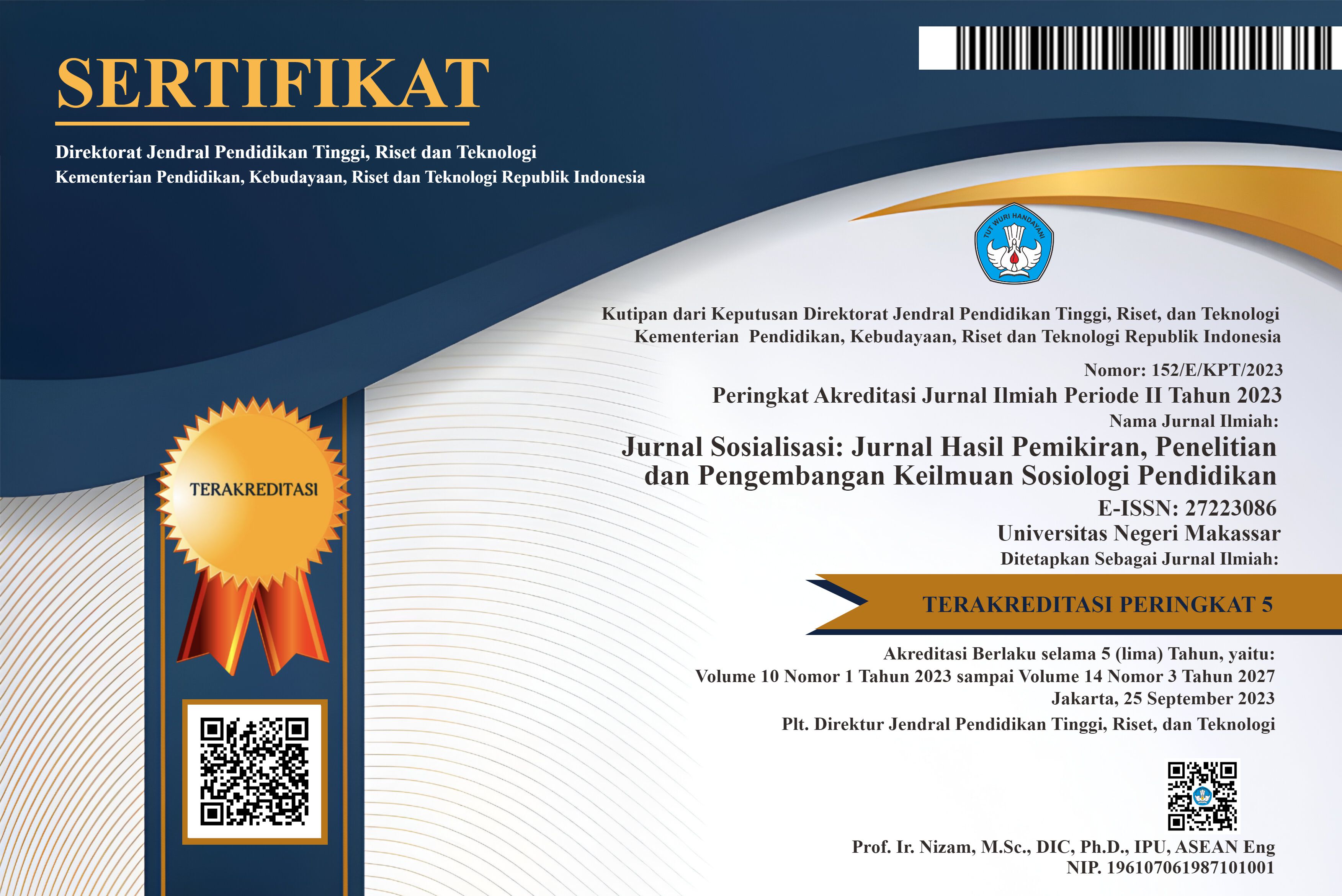Assessing Whatapp for Communication in A Youth Organization: A Dual Method Approach
(1) National Open University of Nigeria, Abuja, Nigeria
(*) Corresponding Author
DOI: https://doi.org/10.26858/sosialisasi.v1i1.21948
Abstract
Communication is pertinent to the existence of all human endeavours. Without communication, most sectors of our endeavours may be deformed. This study assesses the impact of communication among diocesan youth executives of the Anglican Youth Fellowship (AYF) in the Diocese of Abuja. The scholars employed the dual methodology in conducting the study. Eighteen (18) executives from the diocese were interviewed and surveyed. Findings from the study reveal that the Anglican Youth Fellowship (AYF) Diocese of Abuja to a large extent uses WhatsApp for communication purpose. It was also found that the affordability and ease of use of the application motivate the youth executives to use WhatsApp. The overarching themes that emerged in the qualitative study include ease of communication and manipulation, cost-effectiveness, purpose tailored, closely-knitted, distraction. Revelations from the quantitative survey show that a higher percentage of the respondents affirm that WhatsApp is a preferred tool for communication. The study is anchored on Media Richness Theory (MRT). Despite the gains of WhatsApp, albeit, the research found that there are distractions in the communication flow due to the sharing of unsolicited contents on the group, which may derail conversion. The study concludes that WhatsApp has proved to be useful in the youth organization.
Keywords
Full Text:
PDFReferences
Ahad, A. D., & Lim, S. M. A. (2014). “Convenience or Nuisance?: The “WhatsApp” dilemma”. Procedia - Social and Behavioral Sciences, 155, pp. 189–196. https://doi.org/10.1016/j.sbspro.2014.10.278
Ashley, H., & Kathleen, C. (2016). The application of social media in social work community practice. Social Work Education, 35(3), 271-283.
Aula, P., Poutanen, P., & Siira, K. (2016). Complexity and organizational communication: A quest for common ground. Human Resource Development Review, 15(2), 182-207.
Beitzinger, F., & Zowislo-Grünewald, N. (2013). Organizational communication and social media–Challenges for strategizing in business and political communication. In G. Gonçalves, I. Somerville, & A. Melo (Eds.), Organisational and Strategic Communication Research. Livros Labcom Books.
Bouhnik, D., & Deshen, M. (2014). WhatsApp goes to school: Mobile instant messaging between teachers and students. Journal of Information Technology Education: Research, 13, 217-231.
Boyatzis, R.E., (1998). Transforming qualitative information. Sage.
Boyinbode, O.K., Agbonifo, O.C., & Ogundare, A. (2017).Supporting mobile learning with whatsapp based on media richness. Circulation in Computer Science, 2(3) 37-46. https://doi.org/10.22632/ccs-2017-251-89.
Braun, V. & Clarke, V. (2006). Using thematic analysis in psychology. Qualitative research in psychology, 3 (2), 77-101.
Campbell, S., & Park, Y. (2008). Social implications of mobile telephony: The rise of personal communication society. Sociology Compass, 2(2), 371-387.
Chiridza, P., Yorodani, J., Sigauke, E., & Katsaruware, R. D. (2016). Social media and the society: A case study of WhatsApp in Zimbabwe. New Media and Mass Communication, 45, 46–50. https://doi.org/10.7176/NMMC.vol4546-50
Church, K., & Oliveira, R. D. (2013). What’s up with whatsapp? Comparing mobile messaging behaviour with traditional SMS. MOBILE HCI – Collaboration and Communication, 352-361. https://doi.org/10.1145/2493190.2493225
Daft, R. L., & Lengel, R. H. (1984). Information richness: A new approach to managerial behavior and organization design. In B. Staw & L. L. Cummings (Eds.), Research in organizational behavior, 6, 191-233. JAI Press.
Deepthi, Patil, S., & Tadasad, P. (2015). Usage of Whatsapp messenger amongst post-graduate students in a university environment: A study of Karnataka state women’s university, Vijayapura. International Journal of Multidisciplinary Research and Development, 2(11), 591-594.
Drago, E. (2015). The effect of technology on face-to-face communication. The Elon Journal of Undergraduate Research in Communications, 6(1), Article e13.
Efimova, L., & Grudin, J. (2007, January 3-6). Crossing boundaries: A case study of employee blogging [Paper presentation]. Fortieth Hawaii International Conference on System Sciences (HICSS-40). Hawaii, The United States.
Fish, R. S., Root, R. W., Chalfonte, B. L., Root, R. W., & Chalfonte, B. L. (1990). Informal communication in organizations: Form, function, and technology. Human Reactions to Technology: Claremont Symposium on Applied Social Psychology, 145–199.
Gray, J., & Laidlaw, H. (2002). Part-time employment and communication satisfaction in an Australian retail organization. Employee Relations, 24(2), 211-228.
Hamilton, C. (2008). Communicating for results: A guide for business and the professions (8th Ed.). Thomson Wadsworth.
Ibrahim, J., Ros, R., Sulaiman, N., Nordin, R., & Yuan, L. (2014). Positive impact of smartphone application: Whatsapp & Facebook for online business. International Journal of Scientific and Research Publications, 4(12), 1-4.
Jebakumar, & Jisha, K. (2014). Whatsapp: A trend setter in mobile communication among Chennai youth. IOSR Journal in Humanities and Social Science, 19(9), 1-6.
Kaplan, A. M., & Haenlein, M. (2010). Users of the world, unite! The challenges and opportunities of social media. Business Horizons, 53(1), 59–68. https://doi.org/10.1016/j.bushor.2009.09.003
Ledbetter, A. M., Mazer, J. P., Degroot, J. M., Meyer, K. R., Mao, Y., & Swafford, B. (2011). Attitudes toward online social connection and self- disclosure as predictors of Facebook communication and relational closeness. Communication Research, 38(1), 27–53. https://doi.org/10.1177/0093650210365537Journal of Advanced Publications
Kariuki, N.F.W., (2017). Use of whatsapp as an organizational communication platform: a case of Kenyan’s Safaricom technology division. http://erepo.usiu.ac.ke/bitstream/handle/11732/3608/KARIUKI%20NAOMI%20FAITH%20WARIARA%20MSC%202017.pdf?sequence=1&isAllowed=y
Ling, H.Y. (2016). Investigating the perception of secondary school students in Kuching, Sarawak in using Whatsapp for communication and learning purposes. http://woulibrary.wou.edu.my/theses-project/MED2016_YLHSU.pdf
Mefolere, K.F, (2016). WhatsApp and information sharing: Prospect and challenges. International Journal of Social Science and Humanities Research. 4(1), 615-625. 2456-9992
O’hara, K. P., Massimi, M., Harper, R., Rubens, S., & Morris, J. (2014). Everyday dwelling with WhatsApp [Paper presentation]. 17th ACM Conference on Computer Supported Cooperative Work & Social Computing - CSCW ’14, Baltimore, MD, America.
Quan-Haase, A., & Young, A. (2010). Uses and gratifications of social media: A comparison of Facebook and instant messaging. Bulletin of Science, Technology & Society, 30(5), 350-361.
Salem, M., & Soliman, D. (2014). Investigating intention to use mobile instant messenger: The influence of sociability, self-expressiveness, and enjoyment. The Journal of American Academy of Business, Cambridge, 19(2), 286-293.
Socha, B., & Eber-Schmid, B. (2014). What is new media? http://www.newmedia.org/what-is-new-media.html.
The Guardian Newspaper (2017, November 12). The Anglican Youth Fellowship @ 70: How it all started. https://guardian.ng/sunday-magazine/ibru-ecumenical-centre/anglican-youth-fellowship-at-70-how-it-all-started/
Udenze, S. (2019). The pros and cons of using new media in news gathering and reporting. International Journal of Informatics, Technology & Computers, 2 (1), 6 – 10.
Udenze, S. (2019). WhatsApp platform for collaborative learning among students of university of Abuja. Unpublished MA thesis submitted to the Department of Theatre Arts, University of Abuja, Nigeria.
Udenze. S, (2017). Is WhatsApp messaging subsuming conventional SMS? International Journal of Advanced Research and Publications, 1(6), 105-109.
UK Government. (2007). The evolution of communication. United Kingdom: Creative commons attribution. https://www.wired.co.uk/article/history-of-creative-commons
Yeboah, J. & Ewur, G., D. (2014). The impact of WhatsApp messenger usage on students' performance in tertiary institutions in Ghana. Journal of Education and Practice, 5(6), 157-164. ssu2017www.ijarp.org
Yin, L.C. (2016). Adoption of WhatsApp instant messaging among students in ipoh higher education institution. http://woulibrary.wou.edu.my/theses-project/MED2016_CYLEE.pdf
Whatsapp. (n.d.). WhatsApp. http://blog.whatsapp.com/
Article Metrics
Abstract view : 139 times | PDF view : 24 timesRefbacks
- There are currently no refbacks.

This work is licensed under a Creative Commons Attribution 4.0 International License.


































